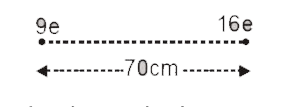Two charges 2μc and 1μc are placed at a distance of 10 cm. Where should a third charge be placed between them so that it does not experience any force.
Q1=2μC=2×10−6C
Q2=1μC=1×10−6C
d=10cm
Let the third charge Q be placed at a distance of X from Q1 then x = ?
The resultant force on 3rd charge is zero.
−→FR=−→F1+−→F2=0 −→F1+−→F2=0
Q1x2=Q2(d−x)2⇒2×10−6x2=1×10−6(10−x)2
By square rooting on both sides
1.414x=110−x⇒x=5.9cm from 2μC. (or)
Shortcut
x=d√q2q1±1=10√21+1=102.414 = 4.1 cm from 1μC
[+ for like charges, - for unlike charges].
Similar Questions
Two charges 2μCand1μC are placed at a distance of 10cm. Where should a third charge be placed between them so that it does not experience any force.
View SolutionTwo charges 9μCand1μC are placed at a distance of 30cm. The position of third charge from 9μC between them so that it does not experience any force.
View Solution
Knowledge Check
Two point charges 2q and 8q are placed at a distance r apart. Where should a third charge −q be placed between them so that the electrical potential energy of the system is a minimum
Aat a distance of r/3 from 2qBat a distance of 2r/3 from 2qCat a distance of r/16 from 2qDNone of the aboveTwo charge are placed as shown in fig. Where should be a third charge be
 A30 cm from 9eB40 cm from 16 eC40 cm from 9eD(A) or (B)
A30 cm from 9eB40 cm from 16 eC40 cm from 9eD(A) or (B)
Two charges 1 μ C and 1 μ C are placed at a distance of 10cm .The position of third charge between them so that it does not experience any force
View SolutionTwo charges 1μ C and 1μC are placed at a distance of 10cm .The position of third charge between them so that it does not experience any force
View SolutionTwo point charges 2q and 8q are placed at a distance r apart. Where should a third charge −q be placed between them so that the electrical potential energy of the system is a minimum
View SolutionTwo charges q and −3q are placed fixed on x-axis separated by distance d. Where should a third charge 2q be placed such that it will not experience any force ?
View Solution(a) Two point charges Q and 16Q are fixed at separation d. Where should a third point charge be placed between them so that it experiences no force I.e. in equilibrium ?
(b) In the previous problem , if we replace Q by −Q , where should the third charge be placed on the joining the charges so that it is equilibrium ?
(c ) Three point charges Q,q and Q are placed at x=0,x=d/2 and x=d. Find q in terms of Q so that all charges are in equilibrium.
(d) Two point charges 9Q and 25Q are placed at separation d. Where should a third charge q be placed between them so that all charges are in equilibrium ? Also find the value of q and its nature.
View SolutionTwo charges q and -3q are placed fixed on x-axis separated by distance d. where should a third charge 2q be placed such that it will not experience any force?
View Solution
